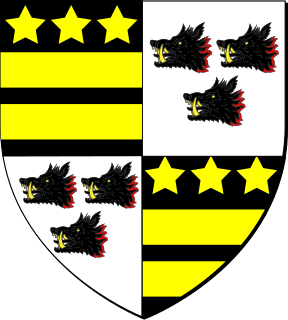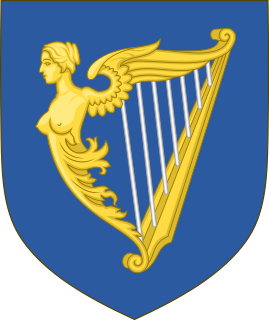
Earl of Gosford is a title in the Peerage of Ireland. It was created in 1806 for Arthur Acheson, 2nd Viscount Gosford.

Earl of Rosse is a title that has been created twice in the Peerage of Ireland; both times for the Parsons family.

Baron Carbery, of Carbery in the County of Cork, is a title in the Peerage of Ireland. It was created in 1715 for George Evans, with remainder to the heirs male of his father and namesake George Evans, a supporter of William and Mary during the Glorious Revolution, who had earlier declined the offer of a peerage. After his elevation to the peerage Lord Carbery represented Westbury in the House of Commons. He was succeeded by his eldest son, the second Baron. He also sat as Member of Parliament for Westbury. His grandson, the fourth Baron, briefly represented Rutland in Parliament. He was succeeded by his uncle, the fifth Baron. On his death the line of the eldest son of the first Baron failed. He was succeeded by his first cousin once removed, the sixth Baron, who had previously succeeded his father as second Baronet, of Castle Freke. Lord Carbery sat in the House of Lords as an Irish Representative Peer from 1824 to 1845. His nephew, the eighth Baron, was an Irish Representative Peer from 1891 to 1894. As of 2014 the titles are held by the latter's great-great-grandson, the twelfth Baron, who succeeded his father in 2012.
Baron Wrottesley, of Wrottesley in the County of Stafford, is a title in the Peerage of the United Kingdom. It was created in 1838 for Sir John Wrottesley, 9th Baronet. He was a Major-General in the Army and also represented Lichfield, Staffordshire and Staffordshire South in House of Commons. He was succeeded by his son, the second Baron. He was President of the Royal Astronomical Society as well as of the Royal Society. His son, the third Baron, held junior positions in the first two Liberal administrations of William Ewart Gladstone. He was succeeded by his eldest son, the fourth Baron. On his death in 1962 the titles passed to his nephew, the fifth Baron who was the only son of the Hon. Walter Bennet Wrottesley, youngest son of the third Baron. In 1941 he married into the Noble House of Stratford, from which all subsequent Barons Wrottesley descend, and in 1963 he sold the Staffordshire estate. As of 2010 the titles are held by the fifth Baron's grandson, the sixth Baron, who succeeded in 1977. He is the only son of the Hon. Richard Francis Gerard Wrottesley, second son of the fifth Baron.
Baron Congleton, of Congleton in the County Palatine of Chester, is a title in the Peerage of the United Kingdom. It was created in 1841 for the Whig politician and former Secretary at War and Paymaster of the Forces Sir Henry Parnell, 4th Baronet. His eldest son, the second Baron, devoted his life to religious work and was an early member of the Plymouth Brethren. The latter was succeeded by his younger brother, the third Baron. He served in the Royal Navy and fough at the Battle of Navarino in 1827. His eldest surviving son, the fourth Baron, was a major-general in the British Army and served in the Crimean War and in the Anglo-Zulu War. The latter's eldest son, the fifth Baron, was killed in action in Ypres Salient during the First World War and was succeeded by his younger brother, the sixth Baron. As of 2015, the titles are held by the latter's grandson, the ninth Baron, who succeeded his father in 2015.

The title of Earl of Kenmare was created in the Peerage of Ireland in 1801. It became extinct upon the death of the 7th Earl in 1952.
There have been four baronetcies created for people with the surname Hoare, one in the Baronetage of Ireland, one in the Baronetage of Great Britain and two in the Baronetage of the United Kingdom. The second holder of the third creation was raised to the peerage as Viscount Templewood in 1944.
There have been three baronetcies created for members of the Gore family, all in the Baronetage of Ireland. All three titles are extant. The family also holds two earldoms and a barony.
The Tuite Baronetcy, of Sonna in the County of Westmeath, is a title in the Baronetage of Ireland. It was created on 16 June 1622 for Oliver Tuite. At the time of the Norman Invasion of Ireland, Henry II granted to Hugh de Lacy, 1st Earl of Ulster, the lands of Ó Maoilsheachlainn, king of Meath in return for the service of 50 Knights. As one of de Lacy's barons Risteárd de Tiúit received large grants in Westmeath and Longford. His descendants became the barons of Moyashell, in Westmeath. De Lacy conferred on the Tuite family the castle of O'Casey, chief of Saithne, now "Sonnagh," in Westmeath. The seventh Baronet was murdered at Sonnagh. This senior branch of the family became Protestant in order to hold on to their lands and in the early twentieth century moved to Britain. The Sonnagh estate is today in ruins outside the town of Ballynacargy in County Westmeath.

There have been four baronetcies created for persons with the surname Hope, three in the Baronetage of Nova Scotia and one in the Baronetage of the United Kingdom. As of 2010 one creation is extant, one dormant and two extinct.
There have been three baronetcies created for persons with the surname O'Neill, two in the Baronetage of Ireland and one in the Baronetage of the United Kingdom.
There have been three baronetcies created for persons with the surname Wilmot, one in the Baronetage of Ireland and two in the Baronetage of Great Britain. One creation is extant as of 2008.
There have been four baronetcies created for persons with the surname Butler; two in the Baronetage of Ireland and two in the Baronetage of the United Kingdom. As of 2014 two of the creations are extant.

There have been two baronetcies created for persons with the surname Freke, one in the Baronetage of Great Britain and one in the Baronetage of Ireland.
There have been three baronetcies created for persons with the surname Cooke, two in the Baronetage of England and one in the Baronetage of Ireland. One creation is extant as of 2013.

There have been four Baronetcies created for persons with the surname Johnston, two in the Baronetage of Nova Scotia, one in the Baronetage of Ireland and one in the Baronetage of the United Kingdom. One creation is extant as of 2010.
The Stewkley Baronetcy, of Hinton in the County of Southampton, was a title in the Baronetage of England. It was created on 9 June 1627 for Hugh Stewkley. The title became extinct on the death of the second Baronet in 1719.
The Sheriff of County Dublin was the Sovereign's judicial representative in County Dublin. Initially an office for lifetime, assigned by the Sovereign, the Sheriff became an annual appointment following the Provisions of Oxford in 1258. Besides his judicial importance, the sheriff had ceremonial and administrative functions and executed High Court Writs.

There have been two baronetcies created for persons with the surname Cox, one in the Baronetage of Ireland and one in the Baronetage of the United Kingdom. Both creations are extinct.
Richard Musgrave may refer to:







